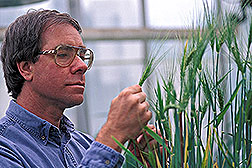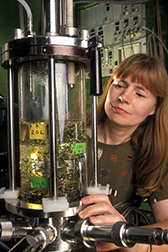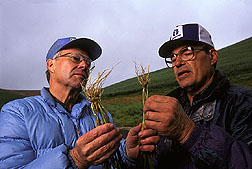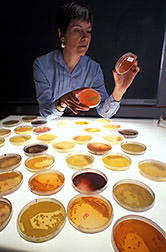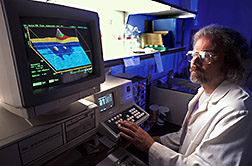Tackling Wheat Take-All
|
|
There's an invisible war going on underneath wheat plants worldwide. On one side is a fungus that causes a devastating root disease known as "take-all." On the other, helpful bacteria.
It's a formidable match.
Both are microscopic soil-dwellers. The fungal organisms are 100 times larger than the bacteria. But the tiny bacterial warriors—billions would fit on your fingertip—produce powerful antibiotics that kill their giant neighbors.
So far, the disease has won most of the battles. Roots turn black as they are eaten alive by the take-all fungus. Wheat may form heads—only to prematurely die. Typically, yields drop 10 to 50 percent, but the disease can "take all" of the crop.
Losses from take-all and other root diseases cost U.S. wheat farmers about $1-½ billion annually, up to 15 percent of the total crop value.
"The environment also suffers," says Agricultural Research Service plant pathologist R. James Cook. Nitrogen from fertilizer goes unused by the dying roots, to perhaps pollute water that moves through the soil.
And growers may be reluctant to adopt new farming techniques that minimize soil erosion, because these same practices can help take-all survive in the field from one crop to the next. Cook explains. He works at the ARS Root Disease and Biological Control Research Unit in Pullman, Washington.
|
|
A farmer's only defense has been to plow under the wheat stubble and alternate wheat with other crops. But barley won't work. Take-all survives on barley stubble, waiting to attack the next wheat crop.
"In the Pacific Northwest, wheat is the most profitable commodity. Farmers want to grow wheat every year, but they must rotate with less economical crops to suppress take-all," says Cook.
Now, after three decades of research, ARS scientists hope to turn the tide on the fungal takeover in the Northwest. Grants from wheat growers and the National Research Initiative (and its predecessor, USDA's Competitive Research Grants Office) of the Cooperative State Research, Education, and Extension Service—along with the O.A. Vogel Wheat Research Fund—have provided additional support for this research.
"Farmers and scientists have known about take-all since the 1800's," says Cook. "By combining the knowledge we've accumulated with new technologies, we have a total management program that should provide farmers with effective and affordable disease control."
These controls—a seed coating, specific farming methods, genetically enhanced bacteria, and a fermentation bioprocess—make up the defense arsenal.
Scientists have long known that fields infested with take-all would eventually begin to yield healthy plants after wheat was grown continuously for many years. But most farmers can't withstand a dozen years of poor yields until nature controls the disease.
In 1988, plant pathologist David M. Weller and geneticist Linda Thomashow, both at Pullman, proved that antibiotics produced by soil-dwelling Pseudomonas fluorescens bacteria were controlling the take-all.
They found that over time, the bacterial populations build up and the antibiotics—phenazine-1-carboxylic acid (PCA) or 2,4-diacetylphloroglucinol (Phi)—defeat the disease. Since then, Weller and Thomashow have found several strains of bacteria that make antibiotics.
A new seed treatment that coats each seed with millions of the bacteria fends off the fungus in laboratory and field tests.
|
|
"The coating places the best bacteria right where the roots can use them. Using treated seeds, we can increase wheat yield 10 to 30 percent in eastern Washington soils," says Weller. Even at 5 percent, farmers would be interested.
"I'm really excited about this research," says John Aeschliman, a Colfax, Washington, wheat farmer who is growing treated wheat seeds for ARS field trials. "We're not applying more chemicals to the soil. We're working with bacteria that are already there," he says.
The next step is to get coated seeds into general use. Key to commercialization is producing enough bacteria to treat the 50 to 60 million pounds of seed needed to plant the fields affected by take-all in the Pacific Northwest each year.
ARS scientists in the Fermentation Biochemistry Research Unit at the National Center for Agricultural Utilization Research (NCAUR) in Peoria, Illinois, are working to solve that problem.
Typically, bacteria are grown on the surface of solid materials such as agar. But in 1989, ARS chemical engineer Patricia J. Slininger tried a new approach.
"By growing the bacteria in liquid," she says, "we can produce greater numbers of the microbes and more precisely control their environment."
Through such control, Slininger and her colleagues at NCAUR can best define which cultural conditions help the bacteria thrive as they are being produced, survive storage, and perform well when they reach harsher field environments.
They also discovered a potential setback: P. fluorescens produced more than just the antibiotic PCA. One of the chemicals formed during PCA synthesis, but not PCA itself, inhibited germination of wheat seeds.
By altering the alkalinity, temperature, and composition of the fermentation media made up of sugars, minerals, vitamins, and amino acids, the researchers learned that they could control the amounts of PCA and germination-inhibiting chemicals produced by the bacteria.
|
|
In the spring of 1995, Cook and his colleagues began their fourth year of field tests using bacteria that were cultured at Peoria.
The fermentation scientists are also exploring how best to harvest bacteria from the liquid, formulate them with other materials such as starch, and dry them to prolong storage.
Typically, there are trade-offs to consider, Slininger says. For example, young bacteria in the late growth stage are generally more disease suppressive. Older ones store better.
Freeze-drying processes are often used to prepare bacteria for long-term storage, but they may be too expensive for wheat. A spray-drying process may be more economical. "Our goal is to keep the cost of applied bacteria down to less than $14 per acre," Slininger says.
Their progress with P. fluorescens will also help with production of other biological control agents. Slininger, plant pathologist David A. Schisler, and their team of researchers are working on liquid culture production of other promising bacteria for plant health.
Many bacteria are needed, because the best treatment for eastern Washington might not work well in western Washington, Kansas, or other wheat-growing areas. That's because different places have different soil and climate conditions, which favor different bacteria.
"Just like wheat varieties that are developed for certain regions, different seed treatments could be developed for each wheat-growing area," says Weller.
Coated seeds could be available to Pacific Northwest farmers within 3 to 4 years. However, even the best seed treatment will probably not, by itself, stop take-all.
Cook has developed several agronomic practices to help, while permitting farmers to use minimum-till or no-till techniques:
- Delay seeding as long as possible.
- Kill grassy weeds and volunteer wheat seedlings well in advance of planting.
- Plant, fertilize, and loosen soil in the seed row with one pass using a no-till drill.
- Plant wheat in paired rows, leaving 10 to 16 inches between pairs.
"This is a win-win system," Cook says. "Doing everything with one pass is a cheaper way to farm, and it leaves more water available in the soil for the wheat to use.
|
|
"With both the seed treatment and agronomic techniques, we can get wheat yields up to 95 percent of the yield we would get in fumigated soil," he continues. Fumigation is impractical at costs up to $1,000 per acre.
Cook notes that these practices also help control Pythium root rot, Rhizoctonia root rot, and other serious wheat diseases.
Genetic engineering offers another tool to spread the benefits of the bacteria faster and farther.
Thomashow identified and cloned the genes in the bacteria responsible for producing the antibiotics PCA and Phi. She inserted the cloned genes into bacteria that originally did not produce antibiotics.
"The transgenic bacteria control take-all better than the original bacteria in the laboratory," says Thomashow. "This will allow us to find bacteria that thrive in each wheat-growing region and improve their disease-fighting ability," she says.
Later this year, pending regulatory approval, Thomashow will test the genetically modified bacteria in the field. The ARS team, in cooperation with Washington State University and the Monsanto Co., field-tested transgenic bacteria on wheat at Pullman in 1988—one of the first tests of its kind in the world.
"It's important to keep in mind that we haven't really introduced anything new to the soil. These genes are already present. We're just putting them into different strains of bacteria, where they work better for a specific location," Thomashow notes.
Natural competition with other soil organisms will keep bacterial populations in check.
This research may also hold the key for engineering wheat plants to resist take-all.
However, Thomashow says using bacteria offers several advantages. "The resistance trait might have to be bred into each wheat cultivar separately. But the bacteria, since they already live in the soil, would work with any variety.
"Also," says Thomashow, "the bacteria produce the antibiotic just where it's needed, in the root zone. There's no concern about antibiotics being produced in the food parts of the plant." — By Kathryn Barry Stelljes, ARS. Ben Hardin, ARS, contributed to this article.
|
A Brief History of Take-All Research 1850's - Australian wheat farmers name a wheat disease "take-all" for its devastating effect on the crop. 1900-45 - Take-all found in wheatfields across the United States. 1967 - ARS begins study of take-all at Pullman, Washington. 1968-70 - Dutch scientists first report that soil eventually controls take-all after years of continuously grown wheat. ARS scientists confirm finding. 1976 - ARS and Australian scientists report that microbes in soil act against take-all. Pseudomonas bacteria implicated. 1985 - ARS scientists patent use of Pseudomonas fluorescens for biological control of take-all. 1988-89 - ARS reports first proof that antibiotics produced by soil bacteria are responsible for take-all decline. Fermentation research on these bacteria begins at Peoria, Illinois. 1992 - ARS scientists identify and clone genes responsible for antibiotic production. 1995 - ARS continues transferring agronomic practices for take-all control to farmers. Seed coating technology is ready for commercial application. Transgenic bacteria are ready for field tests. |
R. James Cook, David M. Weller, and Linda S. Thomashow are in the USDA-ARS Root Disease and Biological Control Research Unit, 365 Johnson Hall, Washington State University, Pullman, WA 99164-6430; phone (509) 335-1116, fax (509) 335-7674.
Patricia J. Slininger and David A. Schisler are in the USDA-ARS Fermentation Biochemistry Research Unit, National Center for Agricultural Utilization Research, 1815 N. University St., Peoria, IL 61604; phone (309) 681-6286, fax (309) 671-7814.







